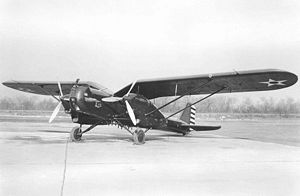Douglas Y1B-7 Video - Picture

|
|
Douglas Y1B-7
Y1B-7

Picture - Y1B-7 of the 31st Bombardment Squadron
Role: Light bomber
Manufacturer: Douglas Aircraft Company
Retired: January 1939
Primary user: United States Army Air Corps
Produced: 1932
Number built: 8
Developed from: Douglas O-35
The Douglas Y1B-7 was a 1930s United States bomber aircraft. It was the first US monoplane given the B- 'bomber' designation. The monoplane was more practical and less expensive than the biplane, and the United States Army Air Corps chose to experiment with monoplanes for this reason. At the time the XB-7 was ordered, it was being tested by Douglas Aircraft as an observational plane.
Design and development
The original XB-7 was an experimental version of a set of monoplanes made by Douglas, which were designated XO-35 and XO-36. The plane was built as a competitor to Fokker YO-27, which eventually led to the Fokker XB-8. The Douglas plane had a single set of wings, which were mounted relatively high (hence their nickname 'gull wings'). The wings were covered by corrugated duralumin. On March 26, 1930, two planes of the design were ordered by the Army Air Corps. Due to minor differences between the two planes, one was designated XO-35 and the other XO-36. Because these two planes had much better performance than most of their predecessors, they were a promising alternative to the slow, bulky Keystone Aircraft Corporation biplanes that made up the entire Army Air Corps bomber fleet at that time.
Impressed by the pair of planes submitted by Douglas, the Army Air Corps chose to complete the XO-36 as a bomber. It was redesignated XB-7, and was equipped with bomb racks capable of carrying up to 1,200 lb (544 kg) of bombs. In August 1931, the Army Air Corps ordered seven Y1B-7 bombers for service testing (along with five Y1O-35s, which became the O-35 in operation service with the 9th Observation Group). The XB-7 was delivered to Wright Field in July 1932, where testing was commenced. A few months later, the first Y1B-7s were delivered. The Y1B-7s were differentiated by having more powerful Curtiss Conqueror engines with streamlined nacelles, and by having three-bladed rather than two-bladed propellers.
The prototype XB-7 was a Light bomber, carrying only 1,200 lb (544 kg) of bombs. The skin of the fuselage was corrugated for ease of production. The gull wing was braced externally to increase strength. While this brace also increased drag, the XB-7 was still faster than any of its biplane predecessors. The crew complement consisted four: a pilot, copilot, and two gunners (one in the nose and one at the tail).
Operational history
Despite positive evaluation, the Y1B-7 was never entered into mass production because of its small bomb load and because newer, more capable aircraft, such as the Martin B-10, were under development. Nevertheless six of the B-7 prototypes, the XO-35 prototype, and the five O-35s all participated in the Airmail Emergency of 1934. All of the O-35s survived and remained in service during the latter 1930's, but four of the B-7's were lost or scrapped in crashes delivering the mail. The surviving two were retired in late 1938 and January 1939.
Operators
United States
United States Army Air Corps
Specifications (Y1B-7)
Data from McDonnell Douglas Aircraft since 1920
General characteristics
Crew: 4
Length: 45 ft 11 in (14.00 m)
Wingspan: 65 ft 0 in (19.81 m)
Height: 11 ft 7 in (3.53 m)
Wing area: 621.2 ft² (57.71 m²)
Empty weight: 5,519 lb (2,509 kg)
Loaded weight: 9,953 lb (4,524 kg)
Max takeoff weight: 11,177 lb (5,080 kg)
Powerplant: 2x— Curtiss V-1570-53 "Conqueror" liquid-cooled V12 engines, 675 hp (504 kW) each
Performance
Maximum speed: 182 mph (158 knots, 293 km/h) at sea level
Cruise speed: 158 mph (137 knots, 254 km/h)
Range: 411 mi (357 nmi, 662 km)
Ferry range: 632 mi (550 nmi, 1,018 km)
Service ceiling: 20,400 ft (6,200 m)
Climb to 10,000 ft (3,050 m): 8.7 minutes
Armament
Guns: 2 x— .30 in (7.62 mm) machine guns
Bombs: 1,200 lb (544 kg) bombs carried beneath fuselage
Comparable aircraft
Fokker XB-8
Bibliography
Francillon, René J. (1979). McDonnell Douglas Aircraft since 1920. London: Putnam. ISBN 0-370-00050-1.
Pelletier, Alain J. (March / April 2006). "Bombers as Postmen:Boeing Y1O-35 and Y1B-7". Air Enthusiast (Stamford, UK: Key Publishing) (122): pp. 30-40. ISSN 0143-5450.
Wagner, Ray (1982). American Combat Planes. New York: Doubleday. ISBN 0-930083-17-2.
Baugher, Joe. "Douglas B-7". Encyclopedia of American Aircraft. http://www.joebaugher.com/usaf_bombers/b7.html. Retrieved April 17, 2010.
"Douglas B-7 USAAC". 1000 Aircraft Photos. http://1000aircraftphotos.com/APS/3402.htm. Retrieved November 17, 2004.
"Fact Sheet:DOUGLAS Y1B-7". National Museum of the USAF. http://www.nationalmuseum.af.mil/factsheets/factsheet.asp?id=2442. Retrieved 26 November 2008.
Douglas Y1B-7 Pictures
More aircraft.
Source: WikiPedia